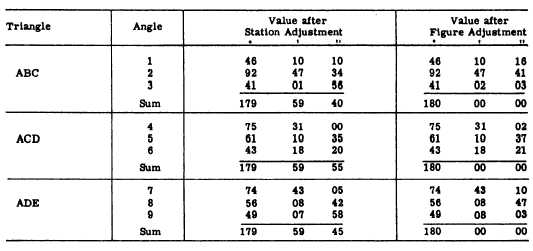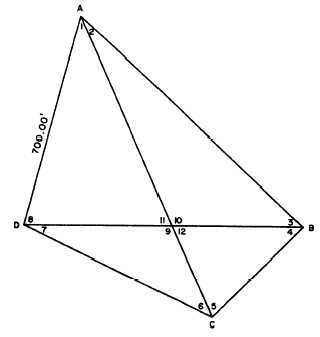Table 15-7.—Figure Adjustment for Chain of Triangles, Figure 15-27
measured angles around each station, determine the
extent to which it differs from 360°, and distribute this
difference over the angles around the station according
to the number of angles.
Figure 15-27 shows a chain of triangles. Station
adjustment for this chain of triangles is given in table
15-6.
At station A, as you can see, the sum of the observed
interior angles 3, 5, and 8 plus the observed exterior
closing angle 12 comes to 360°00´25´´. This differs
from 360° by 25 seconds. The number of angles
around the station is four; therefore, the correction for
each angle is one fourth of 25, or 6 seconds, with 1
second left over. The sum of the observed angles is in
excess of 360°; therefore, 6 seconds was subtracted
from the observed value of each interior angle and 7
seconds from the observed value of the exterior angle.
The angles around the other stations were similarly
adjusted, as shown.
The next step is the figure adjustment for each of
the triangles in the chain. For a triangle, the sum of the
interior angles is 180°. The figure adjustment for each
of the three triangles illustrated in figure 15-27 is shown
in table 15-7.
As you can see, the sum of the three adjusted
observed interior angles in triangle ABC (angles 1, 2,
and 3) comes to 179°59´40´´. This is 20 seconds less than
180°, or 20/3, or 6 seconds for each angle, with
2 seconds left over. Therefore, 6 seconds was added
to the station adjusted value of angle 1, and 7 seconds
each was added to the measured values of angles 2
and 3. The angles in the other two triangles were
similarly adjusted.
ADJUSTING A CHAIN OF QUADRI-
LATERALS.— The station adjustment for a chain of
quadrilaterals is the same as that for a chain of triangles.
The next step is a figure adjustment like that for a chain
of triangles, except that the sum of the interior angles of
a quadrilateral is (4 - 2) 180°, or 360°.
Next, for a quadrilateral, comes another figure
adjustment, based on the four overlapping triangles
within the quadrilateral. To understand this figure
adjustment, study the quadrilateral shown in figure
15-28. The diagonals in this quadrilateral intersect to
Figure 15-28.—Quadrilateral.
15-35




